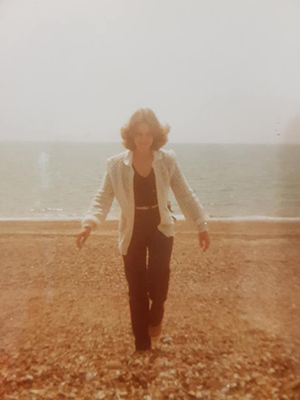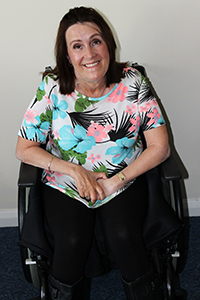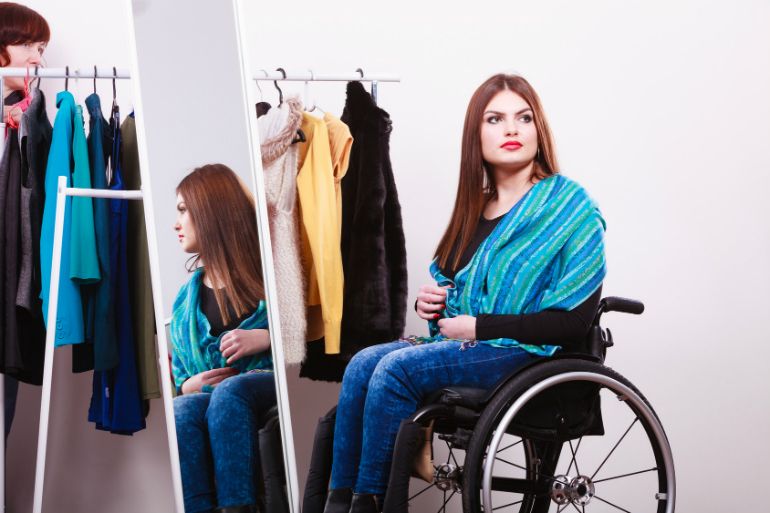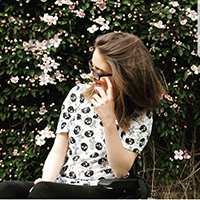Share:
Take it offline!
This Education in Motion resource is also available as a printable PDF.
Download PDF
Wheelchair users and those with reduced mobility can often benefit from wearing adaptive clothing. That is, clothing specifically designed for those who have to spend several hours in the same position, or for those who have difficulty moving or dressing themselves. Adaptive clothing can be very comfortable and can help those who wear it to undertake their day-to-day activities with ease. These types of garment can often allow for a greater degree of independence, as well as making the work of caregivers and family members easier when it comes to dressing and bathing. But can adaptive also be fashionable? One entrepreneur from Reading thinks so.

 Hannah Dunk, Owner at Blossom Boutique Clothing says: “Fashion is a statement. We all have the right to choose our own style and show the world our identities! Fashion is something that defines us and shows our personalities. So when my Mum was diagnosed with Multiple Sclerosis (MS) I questioned the world of fashion for wheelchair users. Why was there so little choice?”
Hannah Dunk, Owner at Blossom Boutique Clothing says: “Fashion is a statement. We all have the right to choose our own style and show the world our identities! Fashion is something that defines us and shows our personalities. So when my Mum was diagnosed with Multiple Sclerosis (MS) I questioned the world of fashion for wheelchair users. Why was there so little choice?”
The practicalities of adaptive clothing
Wheelchair users, who are in a continuously seated position, may find that their legs become more sensitive to temperature changes. Prolonged sitting may also result in ulcers or pressure sores. Pressure sores are painful and, although they can usually be treated without too much trouble, in some instances they can cause extensive skin damage and be the source of serious infections such as Sepsis or Gangrene. Of course, the correct wheelchair cushion can help to prevent these sores. Check out our range of JAY wheelchair cushions to find the right one for you.
Unsuitable clothing may not just impact a wheelchair users comfort but also their health. For example, garments that are wrinkled, creased or which have pronounced seams can exacerbate, or cause, pressure sores or ulcers. There are other practicalities to take into consideration too. As a wheelchair user getting dressed, or undressed, in non-adaptive clothing can be problematic with zips and fastenings being difficult to reach or use.
Adaptive clothing – general features and examples
Wearing adaptive clothing can be beneficial to wheelchair users, thanks to a number of features:
Side openings in trousers and skirts allow wheelchair users to dress in bed, or in a laying down position.
Fastenings such as hooks and Velcro(TM) are often easier to use than buttons and zips. Combine these with adjustable elasticated sections to ensure increased user comfort and easy dressing.
Softer fabrics, which can still withstand the rigours of regular washing, although synthetic materials should generally be avoided as moisture cannot wick away easily with these types of fabric.
Traditionally examples of adaptive clothing would include:
- Nightgowns, protective sheets and incontinence sleepwear for those who may be bedridden for extended periods.
- Wheelchair coveralls which are cut to size to cover the user and the exposed parts of the wheelchair to keep the user dry and prevent water damage to the wheelchair when going out in the rain.
- Thermal blankets and wraps to allow wheelchair users to go outside during the cold weather.
- Adaptive trousers designed with both cut and features in mind so they can be easily put on and removed, as well as tailored to individual needs.

Practicality and style
 Hannah thinks we can do better than the traditional examples of adaptive clothing. She says: “Yes, you can find garments that are comfortable and fit for purpose, but are they on trend? This was so important to my Mum. I grew up with the most glamorous fashionable mother, but the choices for stylish clothing detoriated at the same rate as my Mum’s condition. This saddened me so much and I thought I had to do something about it.”
Hannah thinks we can do better than the traditional examples of adaptive clothing. She says: “Yes, you can find garments that are comfortable and fit for purpose, but are they on trend? This was so important to my Mum. I grew up with the most glamorous fashionable mother, but the choices for stylish clothing detoriated at the same rate as my Mum’s condition. This saddened me so much and I thought I had to do something about it.”
And so she did! She was 19 when her Mum was first diagnosed with MS and Hannah had just been accepted at college to study Interior Design. However, she turned down her place and decided to focus on becoming a carer for her Mum instead. She says: “It was an extremely difficult time for our whole family. Being a young carer was daunting, I had no idea what I was doing and we knew little about the effects of MS.”
“As a young carer for my mother I had no qualifications in fashion or business, so I wasn’t sure where to start. I started analysing what my Mum would need when she was sat down. For non-wheelchair users it’s generally not an issue if material rides up and exposes our stomachs, we can just pull it back down into place. Unfortunately, for my Mum this was getting harder and harder, until she could no longer move her arms independently.”
 “I knew that she needed clothing that was going to stay put all day, but also that was fashionable and which fitted. There were so many T-shirts on the market, but none that fitted nicely, or which were on trend. So I came up with a design that has more coverage at the front to ensure the material does not ride up. The back of the T-shirt is shorter to avoid any excess material bunching up. I made the sleeves longer than a typical T-shirt. Some wheelchair users can find exercising more difficult, so it was important for me to design a T-shirt that covered a bit more skin, no one wants their Bingo Wings exposed!”
“I knew that she needed clothing that was going to stay put all day, but also that was fashionable and which fitted. There were so many T-shirts on the market, but none that fitted nicely, or which were on trend. So I came up with a design that has more coverage at the front to ensure the material does not ride up. The back of the T-shirt is shorter to avoid any excess material bunching up. I made the sleeves longer than a typical T-shirt. Some wheelchair users can find exercising more difficult, so it was important for me to design a T-shirt that covered a bit more skin, no one wants their Bingo Wings exposed!”
But Hannah was keen that her T-shirts didn’t become a complete cover-up, she says:
“My T-shirts are also fitted! Long gone are the days of covering up in an unnecessarily baggy T-shirt, everyone should have the option at least!”
Even things like the placement of the labels in the tops had to be considered.
“The labels in my tops are on the inside seam, avoiding the usual itchy label on your neck.”

What to look for when buying adaptive clothing
There are, of course, many practical considerations to take into account when shopping for accessible clothing. For example, when purchasing trousers:
- Look for a fit that’s cut to adapt to a seated position. This often means the rear is higher than the front to prevent the wearer’s back becoming exposed by the trousers sliding down when seated.
- Opt for trousers in a longer length to avoid the legs being exposed when sitting.
- Try to find adaptive trousers with longer zips which can make them easier to fasten
- Flat, open seams help to avoid chaffing and an elasticated waist also helps to reduce rubbing and provides a more comfortable fit.
- Think about practicality – where are pockets positioned? Are they in a position where you will be able to use and easily access them? Beware of seams and rivets on the rear.
But Hannah offers her own advice to finding suitable clothing:
“With fewer options in the fashion world for wheelchair users you have to improvise.” She suggests:
Buy boots a couple of sizes bigger
My Mum loves knee-high boots but over the years her feet have become swollen, resulting in her ankles turning in. I refused to give up on the shoes that are on the market, so decided to buy boots that were two sizes bigger so we could get them on her feet. Unfortunately for Mum she can no longer walk or transfer herself so boots and shoes are mostly to bring an outfit together and to keep her feet warm, no one wants to go out in slippers!
Consider a poncho instead of a coat
I applied the ‘two sizes’ bigger concept to a coat, but even a few sizes bigger wasn’t helpful, as I cannot physically get her arms through the coat sleeves. I searched and searched until I found a poncho without arm holes.
Jeggings in place of jeans
Jeggi ngs are a huge help when it comes to jeans. They are comfortable and look great with a longer top.
ngs are a huge help when it comes to jeans. They are comfortable and look great with a longer top.
You can find Hannah’s clothing line at Blossom Boutique Clothing.
Alternative adaptive clothing can be found at:
Able2wear.co.uk
Rollitex.co.uk
Willowbug.co.uk
Rollimoden.de
At Sunrise Medical we understand that as a wheelchair user you demand products that look as stylish as they are practical. That’s why our range of manual and powered wheelchairs combine head-turning looks with options that enable you to live without limits.